Maintaining proper tire inflation is relatively simple and essential to the overall tire performance of your vehicle. A properly inflated tire will provide longer life, quicker steering response, better fuel efficiency and a smoother ride than an improperly inflated tire. Both underinflation and overinflation can cause headaches like premature treadwear and possible tire failure. The best way to ensure you're getting the most out of your tires is to check your tire pressure on a monthly basis.
Knowing how to use a tire pressure gauge is very simple. Here’s how to check tire pressure and refill your tires.
Items You Need When Checking Tire Pressure
Tire pressure gauge
Air compressor
Pen and paper
Your tire pressure gauge can be digital or standard. Auto parts stores typically carry both. Many auto parts stores sell portable air compressors that run from your car battery or 12v power port. Alternatively, you can use the air compressor found at most gas stations. They usually cost $0.50 or $1.00 to use.
Vehicle manufacturers specify PSI – literally “pounds per square inch” of pressure – assuming tires are cold. Tires are considered cold when the vehicle has been parked for three hours or more, or if the vehicle has been driven less than a mile (1.6 km) at moderate speed. PSI is the unit your pressure gauge uses to provide readings.
Look on the driver’s side door jamb or your owner’s manual to find the recommended cold tire PSI for your front and rear tires. If you cannot find it, you should consult your vehicle dealer, manufacturer, or a qualified tire professional.
If your front and rear tires require different pressure levels, write down the correct PSI for each to avoid getting confused as you move around your vehicle checking tire pressure.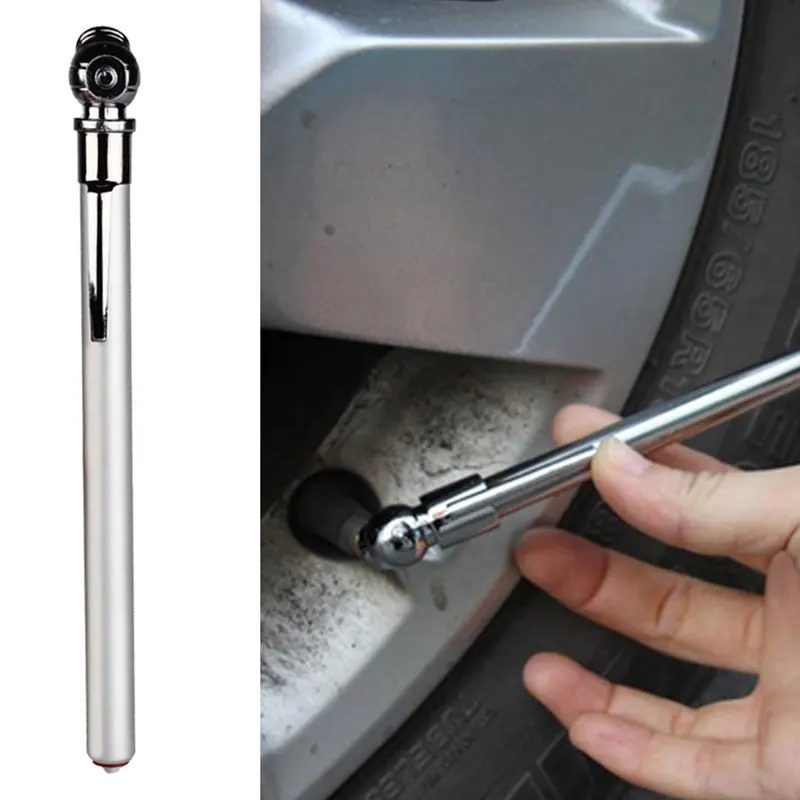
Remove the valve cap from one of your tires. Then place the pressure gauge on the valve stem and press down hard enough so the hiss sound disappears and your gauge provides a reading. With a standard gauge, the air pressure will push a small bar out from the bottom of the gauge. Measurement units are etched into the bar. A digital gauge will show you the reading on a screen.
Write down the reading and repeat this process for all four tires.
Use an air compressor to refill any tires with low pressure. Many air compressors are different, so read directions carefully to be sure you’re using it correctly.
If you’re using the air compressor at a gas station, be sure to park so that the hose will reach all four tires. Insert change into the machine until you hear the motor running. Fill each tire by placing the end of the hose over the valve stem and pressing on the lever.
Using a gas station air compressor means your tires might be “hot. ” If it is necessary to adjust inflation pressure when tires are “hot”, set their pressure to 4 psi (14 kPa) above the recommended cold inflation pressure. Recheck the inflation pressure when the tires are cold.
” If it is necessary to adjust inflation pressure when tires are “hot”, set their pressure to 4 psi (14 kPa) above the recommended cold inflation pressure. Recheck the inflation pressure when the tires are cold.
After filling your tires, use the gauge to check pressure again. At this point, it’s ok if you overfilled the tires because you can always let some air back out. Never drive on overinflated tires. Overinflation can result in decreased traction, premature wear, and decreased impact absorption.
Make the above procedure a monthly ritual. Regularly checking your tire pressure is the best way to ensure your tires never dip far below the optimal PSI.
Accuracy matters and you should keep that in mind when choosing a gauge. For just a few dollars, you can find a quality, accurate tire pressure gauge that gives accurate readings. If you’re not sure which one to purchase, ask a professional technician which he or she prefers.
A digital tire pressure gauge will provide accurate readings, but don’t forget that it operates on a battery. If you think having to replace the battery will prevent you from using it, it’s best to go with a standard gauge.
It’s best to use your personal tire gauge versus those available attached to air hoses at service stations. Of all the pressure gauges out there, they’re the most likely to be weathered, and possibly inaccurate.
There’s never a good time for a flat. That’s why Bridgestone DriveGuard tires are masterfully engineered to keep you moving for up to 50 miles at speeds up to 50 MPH without disruption.
There’s never a good time for a flat. That’s why Bridgestone DriveGuard tires are masterfully engineered to keep you moving for up to 50 miles at speeds up to 50 MPH without disruption.
See Details Find Your Fit
Photo: istockphoto. com
com
Driving is a luxury that many people across the country enjoy, but if proper care isn’t taken to maintain a vehicle, it can result in rapid wear, part failure, and poor control. Tires are one of the features of a car that can sometimes be overlooked, but it’s important to ensure that you know how to use a gauge to check tire pressure. Underinflated tires increase braking distance, reduce steering control, and accelerate tire wear, which can result in complete tire failure. Overinflated tires are not as hazardous, but they can still increase tire wear, affect the wear pattern of the treads, and reduce control. To ensure that your tires are not under- or overinflated, it’s necessary to understand how to use a tire pressure gauge.
Tools & MaterialsIt’s best to check the tire pressure when the tires are cold, such as first thing in the morning or after the vehicle has been parked in the shade for several hours.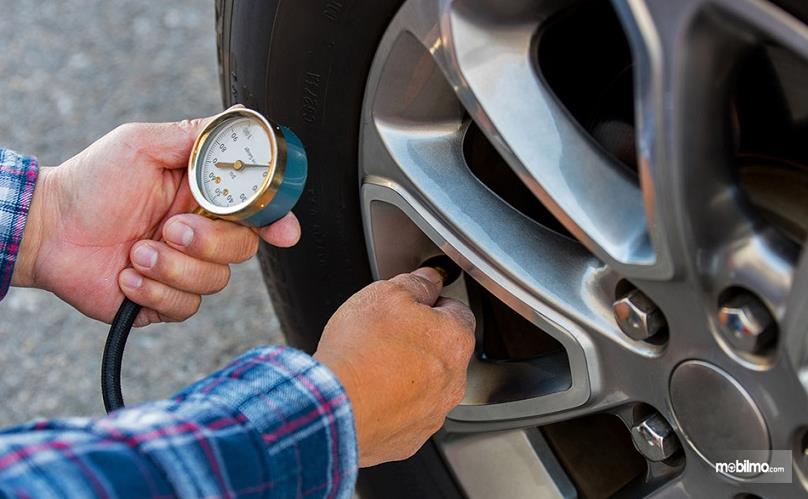 This helps to increase the accuracy of the readings. In order to test tire pressure, you’ll need to purchase a viable tool such as this tire pressure gauge—a favorite in our researched guide to the best tire pressure gauges.
This helps to increase the accuracy of the readings. In order to test tire pressure, you’ll need to purchase a viable tool such as this tire pressure gauge—a favorite in our researched guide to the best tire pressure gauges.
Advertisement
Learning how to use a low-pressure tire gauge is relatively simple, though you will need to find the manufacturer’s recommended PSI before you can begin. While it may seem like the first thing to do is take out the tire pressure gauge, that wouldn’t get you very far unless you already knew the manufacturer’s recommended PSI for the tires. Given that most people don’t typically memorize this information, it’s a good idea to check and verify before using the tire pressure gauge.
Tire and loading information is commonly included in the owner’s manual, though you may also be able to find it on a sticker on the driver’s side door, near the trunk lid, inside the fuel door, or even inside the console. Look for a two-digit number, like 35, followed by PSI, which means pounds per square inch.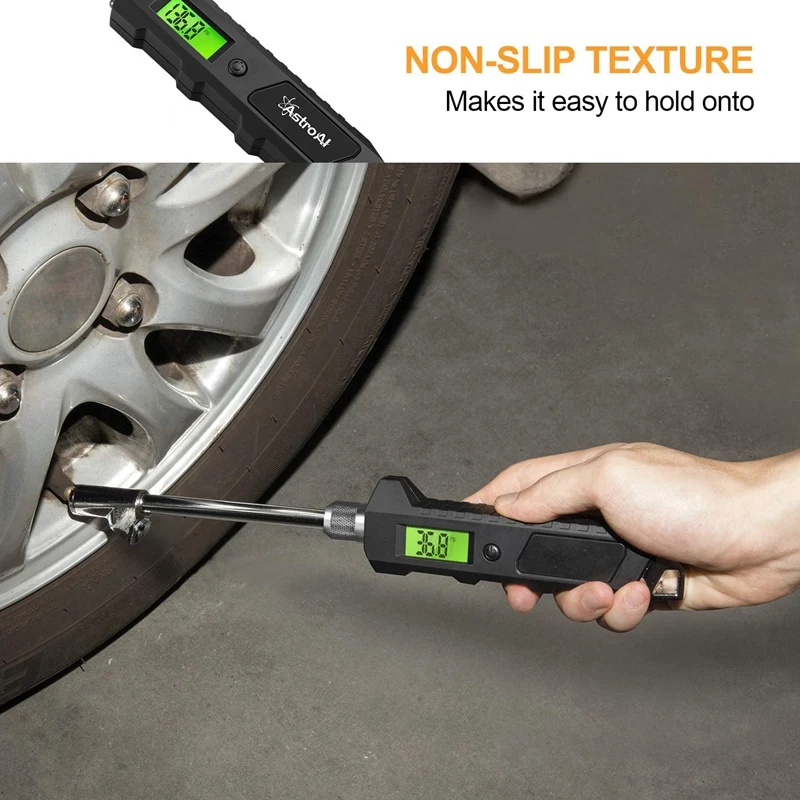
Related: The Best Jump Starters With Air Compressors for Your Car
Photo: istockphoto.com
STEP 2: Locate the tire valve and remove the cap.Each tire has a valve used to inflate or deflate it, depending on the suggested PSI and the current tire pressure. The tire valve is typically a small, black tube about an inch long with a threaded cap. It can commonly be found on the inside of the rubber wheel, protruding through a gap in the hubcap. Locate this valve, then remove the threaded cap so that the tire pressure gauge can fit over the top of the valve. Make sure to keep track of the tire valve cap because it’s very small and easy to lose.
STEP 3: Press the gauge onto the tire valve.The next step to learning how to use a tire pressure gauge is to simply press the gauge down onto the tire valve after the threaded cap has been removed. Each tire valve contains a spring-loaded valve core that automatically seals itself using air pressure from inside the tire.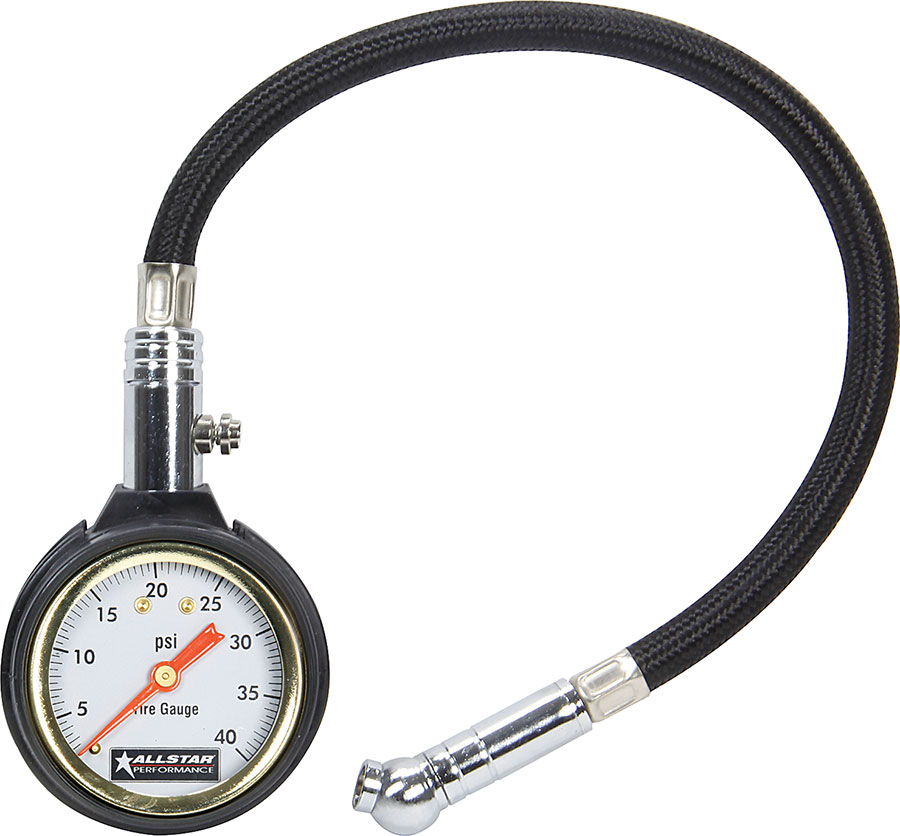 By pressing the gauge against the valve core, the gauge opens the valve to the internal air pressure of the tire and allows the gauge to act as the seal while simultaneously measuring the tire’s PSI rating.
By pressing the gauge against the valve core, the gauge opens the valve to the internal air pressure of the tire and allows the gauge to act as the seal while simultaneously measuring the tire’s PSI rating.
Advertisement
STEP 4: Check the reading on the tire pressure gauge.The tire pressure gauge should be held firmly against the open tire valve so that no air is escaping. If the tire pressure gauge is making a hissing sound, you need to adjust the angle of the gauge inside the tire valve until it is silent. This indicates that the tire pressure gauge is measuring the full tire pressure instead of getting a partial reading due to escaping air. To check the reading on the tire pressure gauge, simply read the slide ruler for manual pen gauges, the dial for dial pressure gauges, or the digital screen for digital pressure gauges. The ruler, dial, or screen should display the current tire pressure in PSI.
Photo: istockphoto.com
After taking the tire pressure measurement, write down the current pressure for each tire so that you don’t forget and need to check again.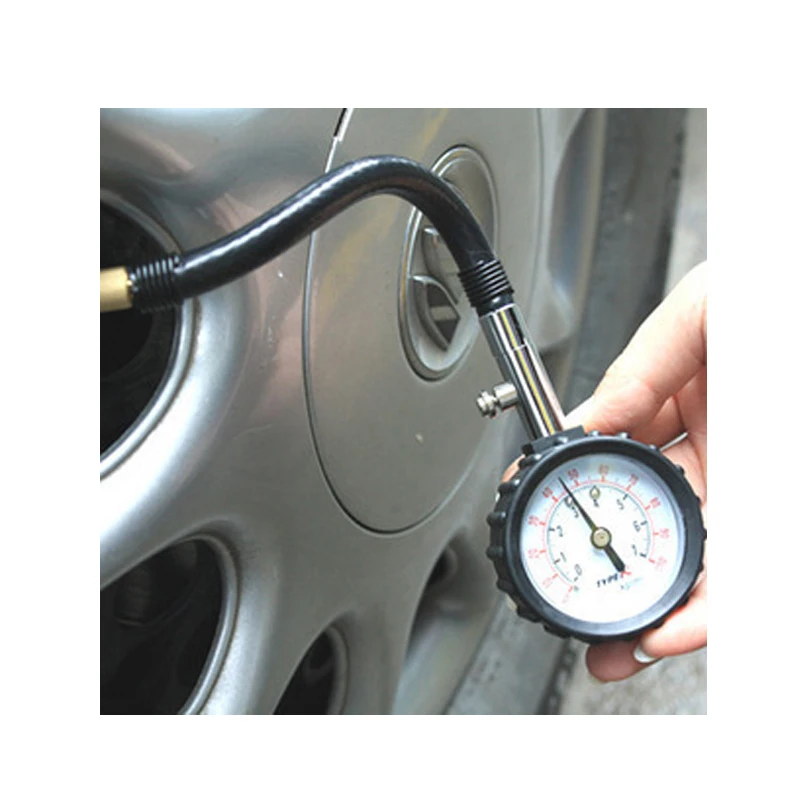 If the pressure within each tire is too high, you can easily drain some air by holding the tire pressure gauge against the tire valve at an angle, listening for the hiss of escaping air. Periodically check the tire pressure to ensure that you don’t drain too much air and stop once you reach the desired PSI.
If the pressure within each tire is too high, you can easily drain some air by holding the tire pressure gauge against the tire valve at an angle, listening for the hiss of escaping air. Periodically check the tire pressure to ensure that you don’t drain too much air and stop once you reach the desired PSI.
If the pressure within the tire is too low, connect an air compressor such as this portable inflator—a favorite in our researched guide to the best tire inflators—to the tire valve to inflate it. After inflating the tire, use the tire pressure gauge to check the PSI and make sure it is now at the correct level according to the manufacturer’s recommendations.
It’s advised to check the tire pressure on your vehicle at least once per month to ensure that you are safe while driving and not doing any unexpected damage to your tires.
Advertisement
RELATED: I Tried a Cordless Tire Inflator―Did It Work?
Final ThoughtsEffectively using a tire pressure gauge is a necessary skill for a driver to have in order to be certain that their vehicle is properly maintained.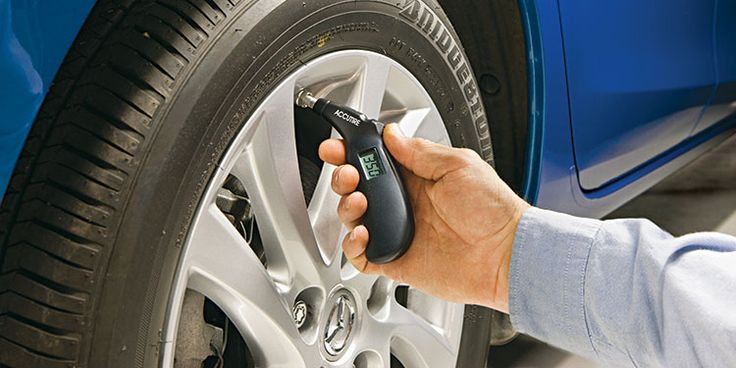 Additionally, by checking the tire pressure of the vehicle, drivers can ensure that they are getting the most out of each tire, instead of accidentally causing premature wear and tear due to overinflated or underinflated tires. Also, keep in mind that you can deflate a car tire with only a tire pressure gauge, but to fill the tire you will need access to an air compressor and a suitable attachment for filling tires. Consider investing in a home air compressor or find a local gas station that has one available for use.
Additionally, by checking the tire pressure of the vehicle, drivers can ensure that they are getting the most out of each tire, instead of accidentally causing premature wear and tear due to overinflated or underinflated tires. Also, keep in mind that you can deflate a car tire with only a tire pressure gauge, but to fill the tire you will need access to an air compressor and a suitable attachment for filling tires. Consider investing in a home air compressor or find a local gas station that has one available for use.
Advertisement
Incredibly, such a simple parameter as tire pressure hides a lot of vehicle performance. For example, accelerated tire wear, increased fuel consumption, poor directional stability and additional stress on the suspension all depend on the amount of air in the wheel. Every motorist should know how to check tire pressure and how often to inspect the wheels.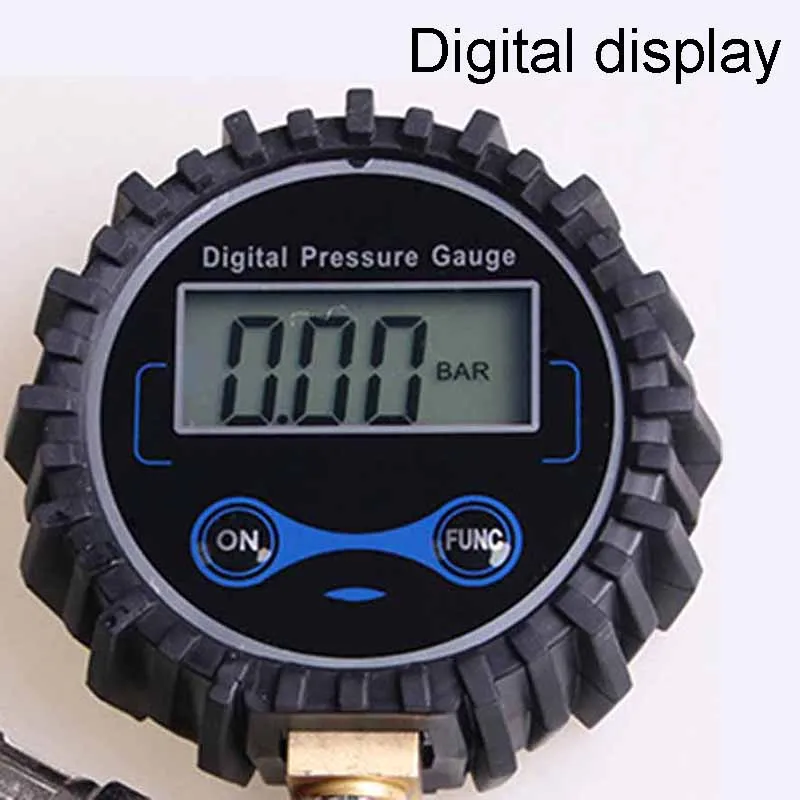 Firstly, these are the safety conditions of traffic rules. Secondly, the rule applies: careful attitude to technology - saves a personal budget.
Firstly, these are the safety conditions of traffic rules. Secondly, the rule applies: careful attitude to technology - saves a personal budget.
A car is a technically complex device. The work of all nodes is accurately calculated by engineers. In order for the car to meet factory specifications, the automaker informs the owner that the operating parameters are being met. One of these parameters is "tire pressure". The requirements for the amount of pressure in the wheels are published in the operating instructions.
In addition, the information is duplicated by a sticker (nameplate) on the rack in the driver's doorway. The plate shows: tire size, rim dimensions and air pressure. Sometimes, the decal is placed in the passenger's doorway or on the inside of the gas cap. The unit of pressure can be specified in bar (Bar), kilopascals (kPa) or pounds (PSi).
According to the technical regulations, it is necessary to measure tire pressure once a month. If the winter period has come, then the check must be carried out 2 times a month. But remember that air is a gaseous substance. It expands when heated and contracts when cold. Therefore, do not check the pressure immediately after stopping the car. Tires need to cool down. The same with low cold, the device is guaranteed to show a lower pressure, which will return to normal after driving, when the air in the tire warms up.
If the winter period has come, then the check must be carried out 2 times a month. But remember that air is a gaseous substance. It expands when heated and contracts when cold. Therefore, do not check the pressure immediately after stopping the car. Tires need to cool down. The same with low cold, the device is guaranteed to show a lower pressure, which will return to normal after driving, when the air in the tire warms up.
Many car owners instinctively kick the wheel with their foot, checking the cylinder for the presence of air. We inherited this manner from our ancestors, kicked by grandfathers and fathers. But this method works from the part when the tire is completely empty and it is no longer possible to drive. Correctly measure the presence of pressure in tires, it is possible only with the help of a pressure gauge. Buying a device is not difficult, as it is sold in any auto shop. Here is a step-by-step guide on how to measure tire pressure yourself:
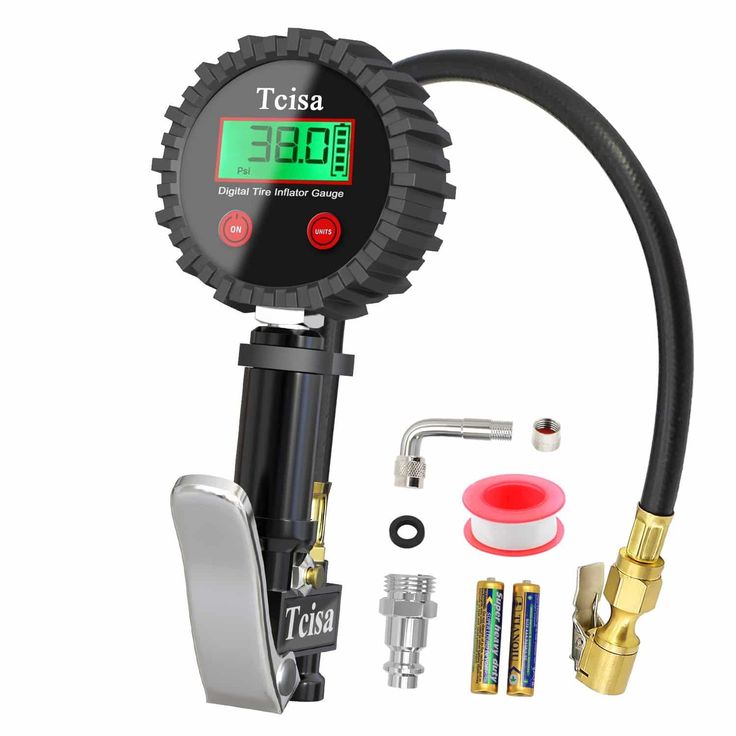 After pumping, it is necessary to read the pressure parameters again (the presence of a pressure gauge on the pump does not ensure the accuracy of measurements).
After pumping, it is necessary to read the pressure parameters again (the presence of a pressure gauge on the pump does not ensure the accuracy of measurements).
Carefully study the scale of the measuring units of your pressure gauge, which can be: Bar, kPa, kg/cm2 and PSi (pounds) measures are different. For example, 2.2 (Bar) would equal 220 (kPa) or 31.908 (psi).
"You can't spoil porridge with oil" - this commandment does not apply to overinflated wheels. Excessive pressure will give discomfort in driving. Along with this, the center of the tread begins to wear out rapidly. The exception to the rule is if you add air on an overloaded car. But, the unloading field, bleed the excess from the cylinders.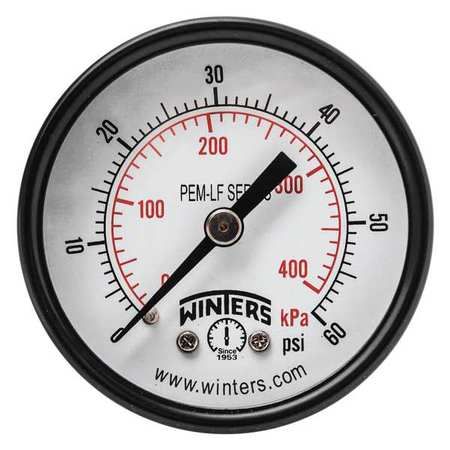
As for the lack of tire pressure, the negative consequences are much greater. Lack of air, guaranteed to provide:
It is important to know that the tire pressures on the rear and front axles are different. In addition, in summer and winter, the wheels should be pumped differently, according to the recommendations of the automaker.
Make it a rule to check your tire pressure regularly. This will extend the life of the wheels for a couple of seasons. Consequently, an increased resource of rubber will make it possible to postpone the purchase of new tires, which is beneficial for the family from an economic point of view.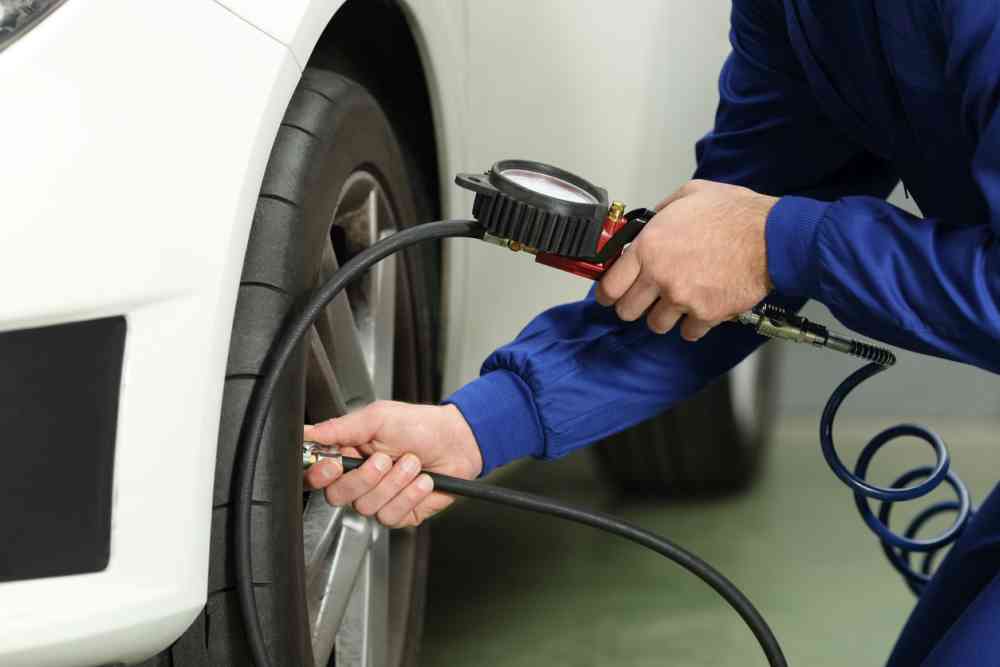
Tire wear, vehicle handling, and therefore driver safety are directly dependent on tire pressure. Therefore, it will not be superfluous to recall what it should be like and how to check tire pressure.
The main units for measuring tire pressure are atmospheres, at least as drivers and mechanics themselves are used to calling them. 1 atmosphere is approximately equal to 1 bar and 10,000 Pascals. But it would be too easy if pascals, bars and atmosphere were the only things that measure tire pressure. Today, more and more often at service points you can find pressure gauges with the PSI scale - this is a foreign pressure scale, which stands for pounds per square inch.
These mysterious PSIs are just different from our atmospheres, for example, 2.0 PSI (or 20 on some scales) in terms of atmospheres or bars will give only 1. 4. It turns out that one PSI is equal to 0.7 bar . So if you pump the wheels at 2.2 atmospheres, then you need to divide 2.2 by 0.7, and you will get the right amount of PSI, namely 3.2.
4. It turns out that one PSI is equal to 0.7 bar . So if you pump the wheels at 2.2 atmospheres, then you need to divide 2.2 by 0.7, and you will get the right amount of PSI, namely 3.2.
How can I check the tire pressure if there is no gas station or service station nearby? You can evaluate this parameter without a pressure gauge, focusing on the appearance of the tread after a long trip on a dry and relatively clean surface. These conditions are rare, but still - if both sides of the tread are clearly darker than the center, this means that the pressure is too low.
The central part of the tread is clearly darker than the edge, which means that the pressure is too high.
However, only a special pressure gauge, which is equipped with all vulcanization stations, service stations and gas stations, will show you true indicators.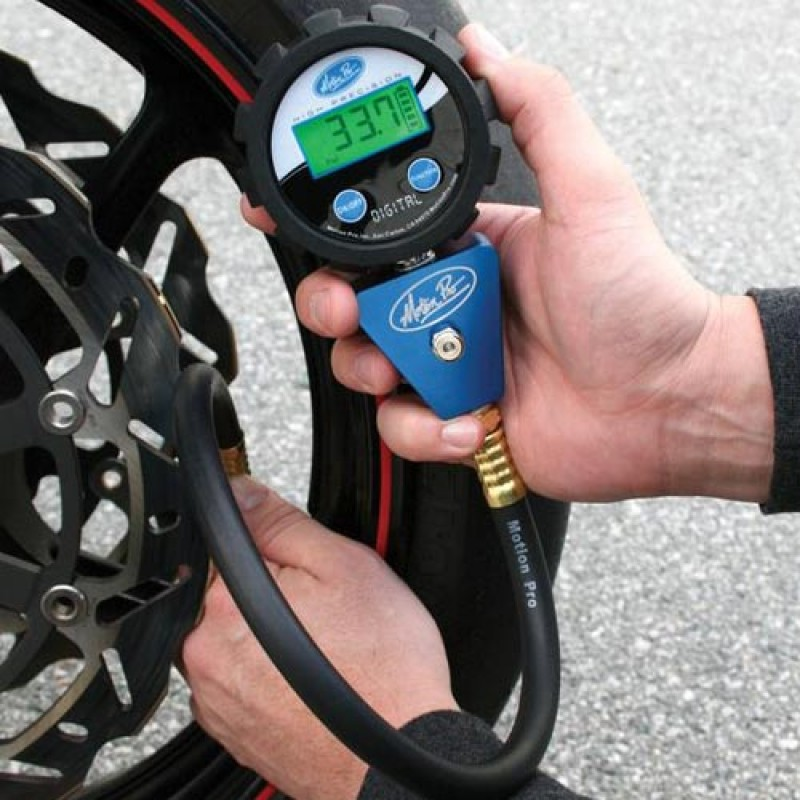 To measure the pressure, you just need to insert the end of the hose into the nipple. However, before check the tire pressure, let the car cool down after driving. For example, if you stop at a gas station and decide to pump up your tires, wait at least 15 minutes before doing so. Tire pressure should be checked at least once every two weeks or after every 2,000 km.
To measure the pressure, you just need to insert the end of the hose into the nipple. However, before check the tire pressure, let the car cool down after driving. For example, if you stop at a gas station and decide to pump up your tires, wait at least 15 minutes before doing so. Tire pressure should be checked at least once every two weeks or after every 2,000 km.
Many drivers buy a pressure gauge for "home" use, so as not to look at the most inopportune moment how to check tire pressure. And this is a very correct step - sadly, but at different service stations and gas stations, pressure gauges can show different data . Therefore, it is worth checking the pressure with your own pressure gauge every time after pumping the wheels, and being guided by your own driving sensations, determine the ideal pressure value.